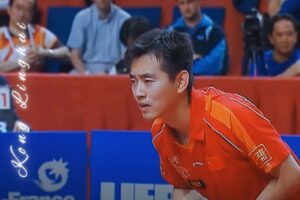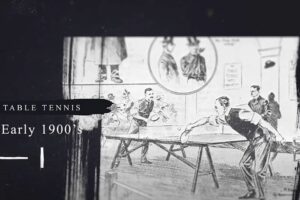Train Table Tennis Alone opens up a world of possibilities for enthusiasts seeking to hone their skills independently. For those passionate about table tennis, the journey to mastery often involves countless hours of dedicated practice. However, finding a practice partner isn’t always easy. This is where the ability to train table tennis alone becomes invaluable. Solo training not only enhances your skills but also builds resilience and self-discipline. From using innovative techniques like multi-ball training to leveraging modern training aids, there are numerous ways to effectively train table tennis alone.
This guide will delve into the best strategies for solo practice, ensuring you can continue to refine your game even when practicing on your own. Whether you’re a beginner or an advanced player, training table tennis alone can lead to significant improvements and newfound confidence.
Mastering Table Tennis with Wall Practice
Wall practice is an essential technique if you want to improve at table tennis solo training. The racket serves as a versatile tool, fostering precision and control in ball striking, elevating your skill level.
Guidelines for Effective Wall Practice:
- Stand at an appropriate distance and height from the wall to simulate realistic ball trajectories and speeds.
- Perform diverse strokes such as forehand and backhand, topspin, and underspin with your paddle to improve adaptability, just like professional players do.
- Maintain a consistent hitting rhythm with the paddle while focusing on ball placement to help you improve overall control. Ensure to hit the ball with precise timing, optimizing your hitting rhythm for superior control and accuracy
- Incorporate footwork patterns to simulate game scenarios and improve agility.
- Set goals and monitor your improvement over time by noting improvements in consistency and accuracy.
Train Table Tennis Alone Through Multiball Training
Utilize multiball training to practice your serve, an essential method for solo table tennis improvement. Play table tennis with a bucket of balls to practice repetitive shots, enhancing speed and precision while simulating diverse in-game scenarios.
Key Points for Effective Multiball Training:
- Utilize the multiball setup to repeatedly practice various shots, aiding muscle memory and consistency.
- Help improve your skill level by mimicking professional players’ game situations and changing the placement of shots to improve adaptability and reflexes.
- If you want to improve, gradually increase the pace of the practice to challenge your reaction time and help improve your overall agility.
- Focus on ping pong ball placement accuracy with your racket to fine-tune targeting abilities for competitive scenarios, bridging the gap between casual play and professional players’ skill levels.
Shadow Play in Table Tennis is an effective way to practice alone.
Shadow play, a solo training method in table tennis, helps players enhance their skills without a partner. This technique involves mimicking strokes, footwork, and movements as if playing against an imaginary opponent.
Practical guidance to train table tennis alone using shadow play:
- Start with stretching your arms, legs, and back to avoid injury. Do arm circles and leg swings to get your blood flowing.
- Practice shuffling side-to-side as if reaching for the ball. Move forward and backward, imagining stepping in for close shots and back for long shots. Keep a low stance for better balance and speed.
- Perform forehand and backhand swings, visualizing an incoming ball. Focus on your swing’s motion and follow through for consistency.
- Practice your serve motion, including the toss and follow-through. Imagine different types of serves like topspin, backspin, and side spin.
- Combine your footwork and strokes to simulate real play. Practice switching between offensive and defensive movements.
- Finish with some light stretching to relax your muscles. Focus on your shoulders, arms, legs, and back to reduce soreness. Regular shadow play improves coordination, technique, and muscle memory, making it an effective method to train table tennis alone.
Elevate Your Skills with Table Edge Bounce in Solo Table Tennis Training
Mastering precision and control is a crucial aspect of table tennis, and one effective way to enhance these skills is through the practice of Table Edge Bounce. Train table tennis alone allows players to refine their technique by bouncing the ball precisely on the edge of the table, providing a unique set of benefits.
Key Aspects of Table Edge Bounce:
- Bouncing the ball on the table’s edge demands accuracy, honing your ability to control the ball’s trajectory with finesse.
- Table Edge Bounce enables players to experiment with spin variations, contributing to a versatile and unpredictable playing style.
- By targeting specific areas of the table edge, players can enhance their ability to place shots precisely, gaining a strategic advantage during matches.
Effective Service Practice in Solo Table Tennis Training
Solo table tennis training offers a unique opportunity to enhance your skills, and one key aspect to focus on is Service Practice. This guide provides a well-rounded approach to perfecting your service techniques, ensuring accuracy and efficiency in your gameplay.
Key Aspects of Service Practice:
- Diversify your service techniques, experimenting with spins, speed, and ball placement. This not only keeps opponents guessing but also hones your adaptability during matches.
- Practice each service technique consistently to build muscle memory, ensuring you can execute them effectively in high-pressure situations.
- Pay attention to the precision of your serves, targeting specific areas of the table tennis table. This improves your control over the game and allows you to dictate the pace.

Essential Drills for Solo Training
Effective footwork is fundamental in table tennis, significantly impacting your game’s speed, control, and overall performance. Engaging in Footwork Drills during solo practice sessions offers a strategic edge and elevates your gameplay.
Key Footwork Drills:
- Practice quick lateral movements along the table’s width, simulating game scenarios where swift side-to-side shifts are essential for optimal positioning.
- Mimic opponent shots or practice footwork patterns without the ball, focusing on precise foot placements and efficient strokes.
- Mark out a circle around the table and move around it continuously, incorporating varied footwork techniques like crossover steps and quick pivots to enhance agility.
- Utilize agility ladders or marked-out lines on the floor to perform intricate footwork patterns, fostering coordination and speed.
Elevate Your Table Tennis Game with Video Analysis
Train table tennis alone with the power of video analysis. Follow these steps to refine your techniques and identify weaknesses:
Set Up Your Recording:
- Use a stable camera or smartphone to record your practice sessions.
- Ensure the camera captures your entire playing area.
Analyze Your Technique:
- Review the footage to observe your strokes, footwork, and overall gameplay.
- Identify areas of improvement, such as stroke mechanics or movement patterns.
Focus on Weaknesses:
- Pinpoint specific weaknesses, whether it’s a consistency issue or a technical flaw.
- Prioritize addressing one or two aspects at a time to avoid overwhelm.
Refine Techniques:
- Implement targeted drills to address identified weaknesses.
- Continuously record and analyze to track progress.
Enhance Your Table Tennis Skills through Mental Visualization
Unlock the power of mental visualization to enhance your table tennis performance when practicing alone. Follow this comprehensive guide for effective mental training:
Visualize Game Scenarios:
- Close your eyes and imagine various game situations, from serving and receiving to strategic rallies.
- Picture yourself successfully executing different strokes and tactics.
Strategize Effectively:
- Engage in mental exercises where you plan your strategies against imaginary opponents.
- Visualize adapting your game plan based on your opponent’s weaknesses.
Mentally Play Through Points:
- Practice mentally playing through entire points, focusing on shot placement, speed, and spin.
- Envision yourself making strategic decisions during critical moments in a match.
Enhance Tactical Understanding:
- Use mental visualization to deepen your understanding of tactical nuances.
- Visualize the ball’s trajectory, your opponent’s movements, and your calculated responses.
Improve Decision-Making:
- Train your mind to make quick and effective decisions by simulating match scenarios mentally.
- Visualize responding to unexpected shots and adapting your strategy on the fly.
Learning from Professional Table Tennis Matches
Enhance your solo table tennis training by incorporating insights from professional matches. Follow this guide for a well-rounded approach to reviewing and learning from top table tennis players:
Watch and Learn:
- Dedicate time to watching professional table tennis matches, available on platforms like YouTube or official sports channels.
- Focus on observing the strategies, tactics, and shot selections employed by elite players during various situations.
Understand Strategies:
- Analyze how top players adapt their strategies based on their opponents’ playing styles.
- Pay attention to the use of offensive and defensive tactics in different phases of the game.
Tactics Employed by Top Players:
- Identify specific tactics such as serves, returns, and placement of shots that distinguish top players.
- Consider how professionals handle pressure situations and make strategic decisions during critical points.
The Benefits of Table Tennis Robot Trainers
Use a table tennis robot to elevate and refine your solo training regimen in table tennis. This comprehensive guide provides insights into the advantages of investing in this technology for your practice sessions:
Varied Shots for Skill Enhancement:
- A table tennis robot trainer offers a diverse range of shots, including topspin, backspin, and side spin.
- This variation in shots helps players improve their stroke techniques, responsiveness, and adaptability to different playing styles.
Consistent Practice Sessions:
- Unlike human practice partners who may tire or have varying consistency, a robot trainer provides unwavering precision in shot placement and speed.
- Consistency in practice is crucial to improving your game, developing muscle memory, and refining overall gameplay.
Investment for Long-Term Improvement:
- While initial costs may seem significant, the long-term benefits outweigh the investment.
- Regular use of a table tennis robot contributes to skill enhancement, making it a valuable tool for dedicated players.

Fitness Training for Solo Table Tennis Improvement
Enhance your table tennis skills through a customized fitness routine that is perfect for practicing table tennis alone. This guide provides a comprehensive and verified approach to enhancing your game performance through fitness training:
Agility Enhancement:
- Concentrate on agility exercises as a way to improve your ability to move quickly and efficiently around the table.
- Agility drills, such as ladder exercises and cone drills, contribute to swift footwork crucial in table tennis.
Flexibility Improvement:
- Incorporate dynamic stretching into your warm-up routine to enhance flexibility.
- Improved flexibility aids in reaching for wide shots and executing dynamic movements with ease.
Core Strength Development:
- Strengthen your core muscles through exercises like planks, twists, and leg raises.
- A robust core enhances stability during shots and contributes to overall body control.
Fostering consistency and patience while practicing table tennis alone.
Playing table tennis alone demands a commitment to consistency and patience for mastery. Here’s a distilled guide leveraging proven offline methods:
Consistent Practice Schedule:
- Implement consistent ways to practice, allocating specific hours each week for solo training sessions. Consistency is key to skill development.
- Engage in drills and exercises daily, focusing on diverse techniques to refine your game steadily.
Embrace Patience for Progress:
- Acknowledge that improvement takes time. Patience allows the gradual refinement of skills and strategies.
- Celebrate small milestones, understanding that each incremental advancement contributes to overall growth.
In Closing
Mastering table tennis solo isn’t just about honing your skills; it’s a journey of self-discipline and dedication. By embracing methods tailored for solo practice, players elevate their game to new heights. Whether it’s perfecting that tricky backhand or improving footwork, every session alone becomes a stepping stone towards excellence in Train Table Tennis Alone. In today’s fast-paced world, the ability to train independently not only sharpens technique but also fosters resilience and determination.
Remember, consistency is key; each serve, each rally counts towards your improvement. So, harness the power of focused, solitary training with proven techniques and watch your game soar in Train Table Tennis Alone. Start your solo journey today and unlock the secrets to mastering table tennis alone.










